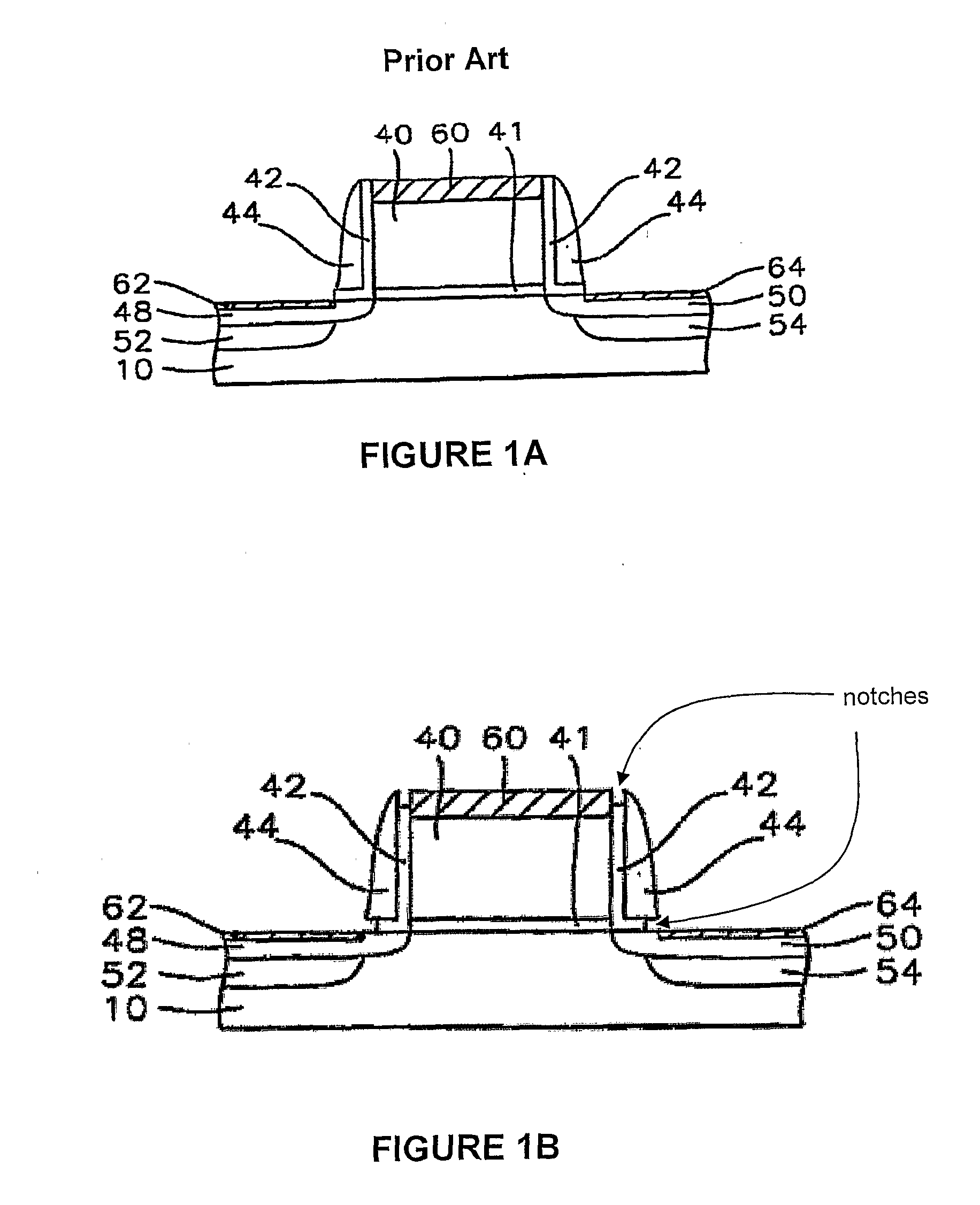Composition and method for selectively etching gate spacer oxide material
a gate spacer oxide and selective etching technology, applied in the direction of electrical equipment, chemistry apparatus and processes, semiconductor devices, etc., can solve the problems of increased parasitic capacitance, device contact resistance, tight tolerance of pattern definition,
- Summary
- Abstract
- Description
- Claims
- Application Information
AI Technical Summary
Benefits of technology
Problems solved by technology
Method used
Image
Examples
example 1
[0071]Subsequent to determining that anhydrous compositions were superior to hydrous compositions in terms of the selectivity of silicon oxide relative to both poly-Si and silicon nitride, the etch rate of silicon oxide, poly-Si and silicon nitride was determined using anhydrous compositions having varying base fluoride:acid fluoride component ratios.
[0072]The samples tested included 1 cm2 blanketed silicon oxide, poly-Si and silicon nitride, which were first measured using an optical interferometer (Nanospec) to determine the pre-immersion thickness, followed by individually immersing each wafer in approximately 50 mL of clean anhydrous composition, rinsing with deionized water, blowing dry with nitrogen and post-immersion measuring using the optical interferometer to determine the change in thickness to derive the etch rate of silicon oxide, poly-Si and silicon nitride in each composition. Silicon oxide was etched for 10 minutes whereas poly-Si and silicon nitride were etched for ...
example 2
[0076]Based on the results from Example 1, the base fluoride:acid fluoride ratio was further decreased and the ratio of TPGME to EG was varied. The experiments outlined in Example 1 were repeated for blanketed silicon oxide and poly-Si at 30° C. Silicon oxide was etched for 10 minutes whereas poly-Si was etched for 30 minutes.
[0077]The anhydrous compositions tested included B1-B4, as listed hereinbelow in Table 3.
TABLE 3Anhydrous compositions B1-B4.NH4HF2 / NH4F / TPGME / IDA / Solutionwt. %wt. %NH4F:HFwt. %wt. %EG / wt. %B12.52.53:10095B22.52.53:12192B32.52.53:16188B42.52.53:110184
[0078]The etch rates and the selectivity of anhydrous compositions B1-B4 at 30° C. are tabulated in Table 4 hereinbelow.
TABLE 4Etch rates of silicon oxide and poly-Si using compositions B1-B4.silicon oxidePoly-Si etchselectivityetch rate / rate / siliconSolutionÅ min−1Å min−1oxide:poly-SiB1259.53.6571:1B2274.63.4181:1B3270.43.090:1B4279.32.71103:1
[0079]It can be seen that the higher the amount of glycol ether (TPGME) ...
example 3
[0080]Based on the results from Examples 1 and 2, various glycol ethers and other chelators were tested at various concentrations to determine the optimum chelator to add to said anhydrous composition. The experiments outlined in Example 1 were repeated for blanketed silicon oxide, poly-Si and silicon nitride at 30° C. Silicon oxide was etched for 10 minutes whereas poly-Si and silicon nitride were etched for 30 minutes.
[0081]The anhydrous compositions tested (C1-C12), each of which included 5 wt. % 3:1 NH4F:HF and 1 wt. % IDA, are listed hereinbelow in Table 5.
TABLE 5Anhydrous compositions C1-C12.TPGME / DPGPE / 400 MWtbutylEG / Solutionwt. %wt. %PEG / wt. %carbitol / wt. %wt. %C12000074C2000292C3000688C40001084C50002074C6020092C7060088C80100084C90200074C10001093C11002092C12004090
[0082]The etch rates and the selectivity of anhydrous compositions C1-C12 at 30° C. are tabulated in Table 6 hereinbelow.
TABLE 6Etch rates of silicon oxide, poly-Si and Si3N4 using compositions C1-C12.Poly-Siselecti...
PUM
| Property | Measurement | Unit |
|---|---|---|
| temperature | aaaaa | aaaaa |
| temperature | aaaaa | aaaaa |
| pH | aaaaa | aaaaa |
Abstract
Description
Claims
Application Information
 Login to View More
Login to View More - R&D
- Intellectual Property
- Life Sciences
- Materials
- Tech Scout
- Unparalleled Data Quality
- Higher Quality Content
- 60% Fewer Hallucinations
Browse by: Latest US Patents, China's latest patents, Technical Efficacy Thesaurus, Application Domain, Technology Topic, Popular Technical Reports.
© 2025 PatSnap. All rights reserved.Legal|Privacy policy|Modern Slavery Act Transparency Statement|Sitemap|About US| Contact US: help@patsnap.com



